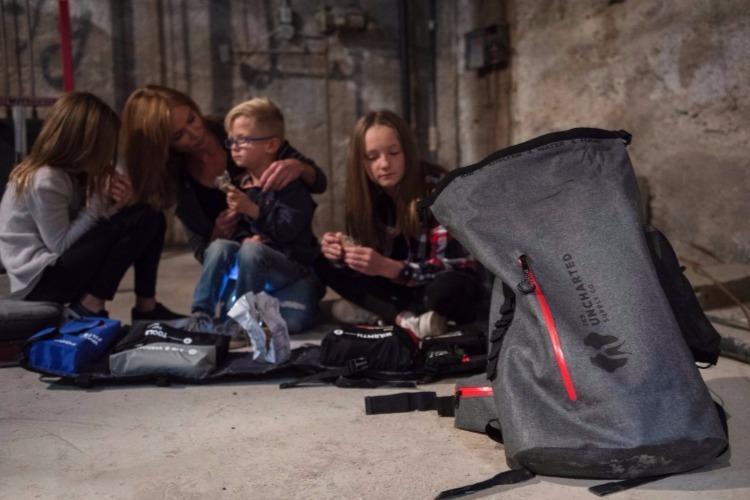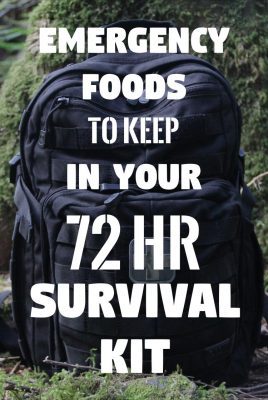A 72-hour food supply is one of the easiest and handiest things you can prepare. When it comes to a short emergency food supply, it is pretty simple, you just start stocking a little more of what you eat every day, and only include the items that have a lengthy shelf life. But how much should you be storing in a 72-hour kit for quick evacuations and short disasters?
For most preppers, an amicable amount of emergency food is within the two-week range, however this varies from household to household and depends on a number of factors such as family sizes, extras for family and friends, diet and of course, whether you’d like to eat homecooked meals in a disaster, or just eat freeze-dried foods and MREs.
While two weeks is a good supply, almost all preparedness individuals and families have a 72-hour disaster kit, which is a three-day supply of emergency food for yourself and is easy to recreate for every other family member or friend.
What you might find in a 72-hour food supply

While the rule of survival stipulates a human can survive for 30 days without food, I am pretty sure no-one wants to do that if they have to. Even going a few days without food isn’t necessary, especially when you can have a small stockpile of emergency food.
Disaster and emergency authorities recommend a minimum supply of three days of non-perishable food, while others suggest two weeks is more appropriate.
When we are looking at a 72-hour food supply it is easy to total up to an average of 2000-2500 calories per person per day. This is also the average amount of calories a person consumes per day, so it is a good starting point.
To calculate this, I generally tend to find lightweight snacks that combine to make a sizeable meal portion. Because we have a 72-hour kit there’s more of a focus on convenience in transportable food than there is for food that you might have to cook, or prepare.
My meal sets are generally broken down into about 700 calories per mealtime, being breakfast, lunch and dinner. In a disaster or other emergency, there might be times when myself, or family, eat less for breakfast and more for lunch and dinner, so in that respect, I made the meal sets to be interchangeable and made up of small components, rather than just three packaged single meals.
Going the freeze-dried food, MRE, or DIY route?

If you have seen survival kits or disaster kits before, you may have noticed a lot of them include freeze-dried foods, or MREs which are an easy and light option to fit into a bag and still pack a lot of nutrition, taste and give you a full belly for breakfast, lunch, or dinner.
You can choose to mix it up, with normal packaged foods and then MREs and freeze-dried meals as well. This gives more variation to the foods you have and opens you up to being able to eat home-cooked-style meals from your emergency food supply.
Although, depending on the type of food you enjoy, you might not want to get freeze-dried foods, as their range can be limiting and their cost high, and instead, you might opt for good old can food or other non-perishable food sources.
If you are happy to go down the track of freeze-dried or ready-to-eat foods, there are great 72-hour food supply kits from trusted and tasty providers such as Mountain House, Auguson Farms and Wise Company.
An example DIY 72-hour food supply menu
There are also cheaper, alternative DIY options to 72-hour food kits that you might prefer, which are completely up to you in what you eat and what you want.
For the DIY route, my 72-hour food supply kit that I made for myself and family members looks like this:
Day One:
- Breakfast: breakfast bar, dried cranberries, rye or wheat biscuits in a packet
- Lunch: peanut butter, crackers, dried fruit and nut mix, can of baked beans in tomato sauce
- Dinner: nuts, tinned tuna with herb mix, instant mash potato
Day Two:
- Breakfast: granola bar, dried fruit and oats with powdered milk (muesli)
- Lunch: protein bar, canned fruit, canned bean mix and corn
- Dinner: baby tin of carrots, crackers, tinned cheese
Day Three:
- Breakfast: protein bar, granola
- Lunch: peanut butter, crackers, mash potato instant mix
- Dinner: canned spaghetti and sausages, crackers
This example DIY 72-hour food option uses foods that have a long shelf life, are cheap and are also light, so as to not sacrifice a cumbersome and oversized bag.
The menu doesn’t include water, which is a must for any emergency food supply, as any food is likely to make you just as thirsty as the stressful environment that you have been thrown in by a natural disaster, or personal emergency. When you are making your 72-hour kit, ensure you have at least three gallons of water per person (one gallon per person per day).
Why do you need a 72hr emergency food supply?

While this post is specifically about the 72-hour food supply, at a bare minimum, everyone should be keeping a three-day food supply. There are countless events where residents in areas have had to leave their homes due to flooding, wildfires, or severe storms in last-minute evacuations and have not had the time, or the capacity to think logically under such a stressful situation, to pack food.
It is understandable that the above list of three days of food isn’t the normal diet, but when it is in a pre-made bag, along with other survival essentials and emergency supplies, sitting in the car, in the garage or next to your front door, it’s as simple as remembering to grab it that will be the difference between those emergency supplies or not.
There are a number of disasters out there that might isolate you and cut the supply of food to your area, whether it be flooding, fires, severe storms or other disasters, both natural and manmade. If food was to be limited, it would only be, and has been in the past, limited for a short time, but there is no reason why you shouldn’t have that small reserve set aside for a rainy day.
While the natural disasters above might have you pent up in your house, without a way to leave your area, if you are evacuating the home, it is generally a last-minute or emergency evacuation that needs to be done quickly and in a rush. So what are you going to grab? For most of us, it’s the irreplaceable things like old wedding videos, photo albums and family heirlooms.
You’re going to have a lot more time to grab those sentimental things if you are not rummaging around in the kitchen cupboard grabbing boxes of cereal. In a quick evacuation, it is going to be a lot easier to have those personally prepared kits of food that have been safely sitting there for a number of months waiting for you to use them in a time like this.
There’s no doubt a three-day emergency kit is essential, and for the fact that it includes the water and top prepper foods you need to stay healthy, then that’s an extremely beneficial preparedness item to have sitting as a backup in the home.
For more on 72-hour kits, visit:
-
- Shark Tank’s 72-Hour Survival Kit: What Is It And Is It Worth The Money?
- Preppers Emergency Food Supply: 5 Excuses Debunked
- 5 Things You Need To Survive In The Urban Environment After A Disaster
- Emergency Food Prepping: 20 Foods That Last A Long Time
- Prepping On A Budget: Complete $5 Item List For An Emergency Supply



I don’t know what kind of food to bring for a hurricane.